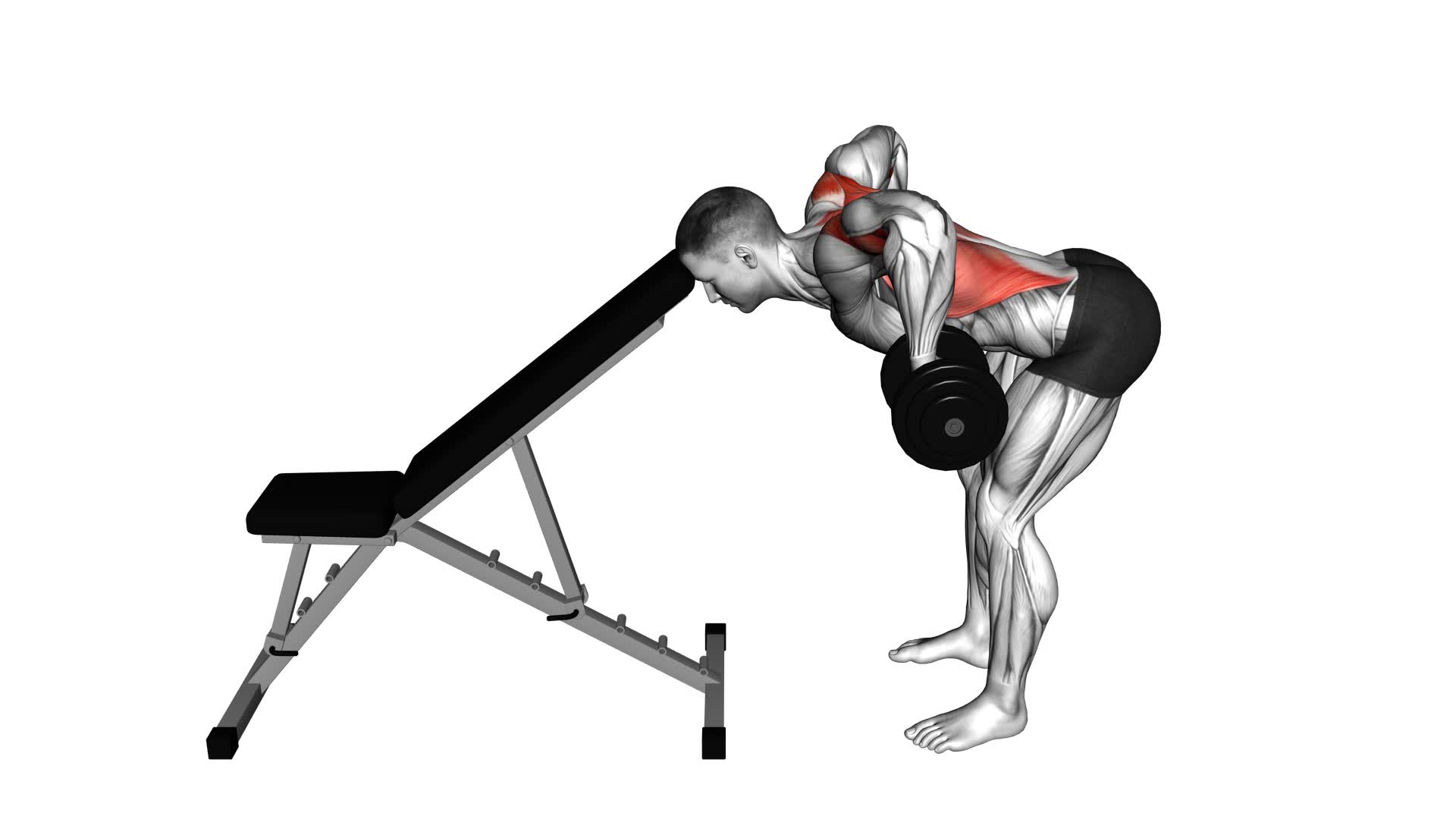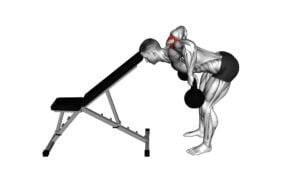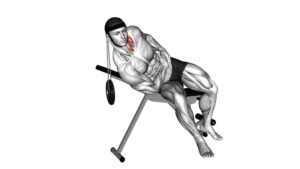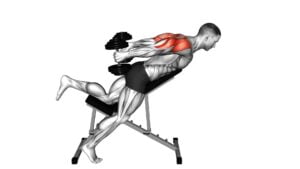Dumbbell Head Supported Row – Video Exercise Guide & Tips

Get ready to strengthen your back and build muscle with the dumbbell head supported row!
Watch This Exercise Video
This video exercise guide and tips will show you the proper form and technique to maximize your results.
Avoid common mistakes and discover variations for advanced training.
With this exercise, you'll be on your way to a stronger, more defined back in no time.
Let's get started!
Key Takeaways
- Dumbbell Head Supported Row targets upper back and shoulder muscles
- Proper form and technique are crucial to maximize results and prevent injury
- Common mistakes to avoid include using too much weight, rounding the back, and jerking or swinging the weights
- Variations and progressions for advanced training can help increase strength and challenge different muscle groups
Benefits of the Dumbbell Head Supported Row
You can experience several benefits from incorporating the dumbbell head supported row into your workout routine. This exercise primarily targets the muscles in your upper back and shoulders, including the rhomboids, trapezius, and deltoids. By strengthening these muscles, you can improve your posture and overall upper body strength. Additionally, the dumbbell head supported row helps to engage your core muscles, providing stability and support during the movement.
To incorporate the dumbbell head supported row into your workout routine, start by selecting an appropriate weight dumbbell. Begin by positioning yourself face down on an incline bench with your chest and head supported. Hold a dumbbell in each hand, with your arms fully extended towards the floor. From this starting position, retract your shoulder blades and pull the dumbbells up towards your ribcage, squeezing your upper back muscles. Lower the dumbbells back down to the starting position and repeat for the desired number of repetitions.
By incorporating the dumbbell head supported row into your workout routine, you can target and strengthen your upper back and shoulder muscles, improving your posture and overall upper body strength.
Now, let's move on to the next section where we'll discuss the proper form and technique for performing this exercise.
Proper Form and Technique for the Exercise
To perform the dumbbell head supported row with proper form and technique, it's important to focus on engaging your upper back and shoulder muscles while maintaining stability and control throughout the movement. Here are some tips to help you execute this exercise correctly:
- Common errors in performing the dumbbell head supported row:
- Rounding the back: Make sure to keep your back straight and avoid rounding your shoulders forward. This helps prevent strain on the lower back.
- Using momentum: Avoid using momentum to lift the weights. Instead, focus on controlled movements and squeeze your shoulder blades together at the top of the row.
- Lifting too heavy: Start with lighter weights and gradually increase the resistance as your strength improves. This ensures proper form and reduces the risk of injury.
How to modify the dumbbell head supported row for different fitness levels:
- Beginner: If you're new to this exercise, start with a lighter weight and focus on mastering the proper technique before progressing to heavier weights.
- Intermediate: Once you have the basics down, you can increase the resistance gradually and challenge yourself with heavier dumbbells.
- Advanced: To further intensify the exercise, you can perform the row on an unstable surface like a balance board or a stability ball. This engages more muscles and enhances core stability.
Common Mistakes to Avoid
When performing the dumbbell head supported row, it's important to be aware of common mistakes that should be avoided. By being mindful of these errors, you can optimize the effectiveness of this exercise and minimize the risk of injury.
One common mistake is using too much weight. It's crucial to choose a weight that allows you to maintain proper form throughout the movement. Using excessive weight can compromise your technique and lead to strain or injury.
Another mistake to avoid is rounding your back. To perform the exercise correctly, keep your back straight and engage your core muscles to stabilize your spine.
Additionally, avoid jerking or swinging the weights. This momentum-driven movement not only reduces the effectiveness of the exercise but also increases the likelihood of straining your muscles.
Lastly, make sure to perform the exercise in a controlled manner. Avoid rushing through the repetitions and focus on the mind-muscle connection.
Tips to Maximize Your Results
To maximize your results, incorporate these key tips into your dumbbell head supported row routine:
- Focus on proper form: Maintain a neutral spine throughout the exercise, engaging your core and keeping your back straight. Avoid excessive swinging or jerking movements, as this can compromise the effectiveness of the exercise and increase the risk of injury.
- Gradually increase the weight: As you become more comfortable with the exercise, gradually increase the weight of the dumbbells to continue challenging your muscles. This progressive overload is crucial for building strength and muscle mass.
- Vary your grip width: Experiment with different grip widths to target different muscles in your back. A wider grip targets the lats, while a narrower grip emphasizes the rhomboids and middle back. By alternating your grip, you can ensure balanced development of your back muscles.
By following these key exercises and training strategies, you can maximize the effectiveness of your dumbbell head supported row routine and achieve optimal results.
Now, let's move on to the next section where we'll explore variations and progressions for advanced training.
Variations and Progressions for Advanced Training
As you progress in your dumbbell head supported row routine, you can explore various variations and progressions to further challenge your muscles and continue maximizing your results. These advanced variations and training progressions will help you push your limits and take your workouts to the next level.
One advanced variation is the single-arm dumbbell head supported row. Instead of using both arms simultaneously, you'll perform the exercise one arm at a time. This variation increases the demand on your core and stabilizer muscles, as well as provides a greater range of motion for each arm.
Another advanced variation is the renegade row. In this exercise, you start in a push-up position with your hands on the dumbbells. From there, you row one arm up while keeping your body stable. This variation not only targets your back muscles but also engages your core and upper body.
To progress in your training, you can increase the weight of the dumbbells gradually. This will further challenge your muscles and stimulate strength gains. Additionally, you can increase the number of sets and reps or decrease the rest time between sets to intensify your workouts.
Remember to always prioritize proper form and technique when performing these advanced variations. It's essential to maintain control throughout the movement and avoid any jerking or swinging motions. With consistency and dedication, you can achieve impressive results with the dumbbell head supported row and its advanced variations.
Frequently Asked Questions
How Many Sets and Repetitions Should I Do for the Dumbbell Head Supported Row?
To determine the number of sets and repetitions for the dumbbell head supported row, you should consider your fitness goals and current level of strength. Start with 3 sets of 8-12 repetitions and gradually increase the weight as you progress.
Remember to maintain proper form and technique throughout the exercise to maximize its effectiveness. Focus on keeping your back straight and engaging your core muscles.
Can I Perform the Dumbbell Head Supported Row With a Barbell Instead of Dumbbells?
Yes, you can perform the dumbbell head supported row with a barbell instead of dumbbells.
This exercise is a great way to target your upper back and improve posture.
The barbell alternative allows for a greater range of motion and can challenge your muscles in a different way.
However, it's important to maintain proper form and control throughout the movement to avoid injury.
Always start with a weight that you can handle comfortably.
Is It Necessary to Use a Bench or Can I Perform the Exercise on the Floor?
You don't have to use a bench for the dumbbell head supported row. You can perform the exercise on the floor if you prefer. It's all about finding what works best for you.
If you don't have dumbbells, you can also try using a barbell or other alternative equipment for this exercise. Just make sure you maintain proper form and engage your back muscles effectively.
Can the Dumbbell Head Supported Row Help Improve My Posture?
Yes, the dumbbell head supported row can help improve your posture. By incorporating this exercise into your routine, you can reap the benefits of improved posture.
Proper form techniques, such as keeping your back straight and shoulders pulled back, will engage the muscles in your upper back and shoulders, helping to strengthen and align them.
This exercise can be a valuable addition to your fitness regimen for promoting better posture and overall body alignment.
Is It Safe to Perform the Dumbbell Head Supported Row if I Have a Pre-Existing Shoulder Injury?
If you have a pre-existing shoulder injury, it's important to take precautions when performing the dumbbell head supported row. This exercise puts stress on the shoulders, which could aggravate your injury.
It's recommended to consult with a healthcare professional or a certified personal trainer before attempting this exercise. They can provide alternative exercises that target the same muscle groups without putting strain on your injured shoulder.
Prioritizing your safety and recovery is key.
Conclusion
In conclusion, the dumbbell head supported row is a highly effective exercise that targets the upper back muscles.
By maintaining proper form and technique, you can maximize your results and avoid common mistakes.
Remember to start with lighter weights and gradually increase as you progress.
Additionally, incorporating variations and progressions into your training can help challenge your muscles further.
With consistency and dedication, you can achieve a stronger and more defined upper body.

Author
Years ago, the spark of my life’s passion ignited in my mind the moment I stepped into the local gym for the first time. The inaugural bead of perspiration, the initial endeavor, the very first surge of endorphins, and a sense of pride that washed over me post-workout marked the beginning of my deep-seated interest in strength sports, fitness, and sports nutrition. This very curiosity blossomed rapidly into a profound fascination, propelling me to earn a Master’s degree in Physical Education from the Academy of Physical Education in Krakow, followed by a Sports Manager diploma from the Jagiellonian University. My journey of growth led me to gain more specialized qualifications, such as being a certified personal trainer with a focus on sports dietetics, a lifeguard, and an instructor for wellness and corrective gymnastics. Theoretical knowledge paired seamlessly with practical experience, reinforcing my belief that the transformation of individuals under my guidance was also a reflection of my personal growth. This belief holds true even today. Each day, I strive to push the boundaries and explore new realms. These realms gently elevate me to greater heights. The unique combination of passion for my field and the continuous quest for growth fuels my drive to break new ground.







